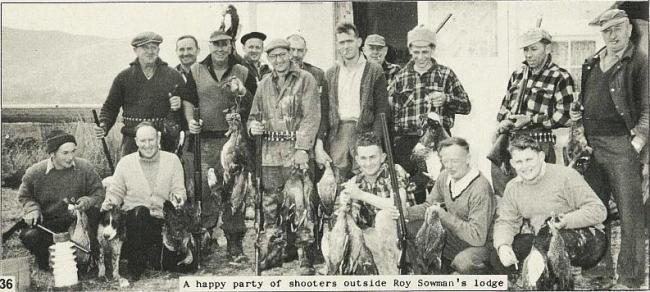Roy Sowman's Lodge
In the early 1950s, Roy Sowman built a modest edifice on the edge of Neiman Creek on the Waimea estuary.
In the early 1950s, Roy Sowman built a modest edifice on the edge of Neiman Creek on the Waimea estuary. What started out as a boatshed, from which Roy could shoot ducks and go fishing, became a second home to many, until in later years, the boatshed-bach became known as “Roy Sowman’s Lodge”.
A lot of the original bach material came from the Cobb Valley Power Station where Roy worked. It is believed this included a packing case from one of the turbines. The outside cladding was made from flattened tar drums and the flat roof was covered with malthoid.
Roy would head off to set up “camp” for the first Saturday of May, the beginning of the duck shooting season. “Camp” became popular with the local reporters for an easy-to-catch duck shooting story and photograph, and the prospect of a duck or two to take home.
King tides caused serious flooding from time to time. During one of these, he put his wife and children on the roof and waded about providing lunch. Many of the seedlings and shrubs planted over the years by Roy and his wife, Faye, succumbed to the salt water or passers-by. However a nucleus of their original plantings have survived and these include banksia, bottlebrush, tamerisk and plum.
Roy Sowman died at the bach in 1966 and his lodge burnt down in the mid 1970s. An acorn taken from a locally shot duck was planted to commemorate Roy and his lodge. Oak seedlings from under that commemorative tree were subsequently planted around the site and many remain today.
Game Bird Hunting
The traditional sport of game bird hunting still occurs today in some parts of the Waimea Estuary. Cyclists may hear the occasional shot during the season that runs from May-July each winter. Most hunting activity within the estuary takes place on the first weekend of May, fondly known by hunters as 'opening weekend'. Game birds are the native Pukeko, Black Swan, Paradise Shelduck, Shoveler and Grey Duck, and introduced species Mallard, Californian Quail and Pheasant. There are few, pure Grey Duck left in New Zealand and most Mallard have grey genes due to hybridising between the two birds, now called ‘Greylards’ by hunters
Written by Janet Bathgate
The text from this story came from the Tasman District Council/ New Zealand Cycle Trail Heritage Panel, 2012
Updated May 7, 2020
Story by: Janet Bathgate
Further Sources
Books
- Airey, Mark. (2010) Gamebird hunting in New Zealand, Auckland, N.Z,: Spot X Publications
- Girvan, Gary. (2007) Duck hunting in New Zealand, Auckland, N.Z.: David Bateman
- South, Bob. (2005). Bird hunting, Auckland, N.Z.: Halcyon Press
Newspapers
- A beginner's guide to duck shooting (2005, April). Lifestyle Farmer, 6 (3), 30-32
- Hale, Steve (2013,May). Opening day. Lifestyle Farmer, 14(5), 22-25
- Hunting in New Zealand (2012, May). Lifestyle Farmer,13 (5), 19-21
- Keen bird hunters anticipate start of the season (2013, May). Lifestyle Farmer, 14 (5), 26-28
